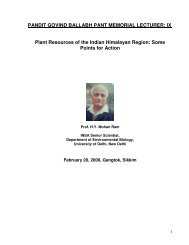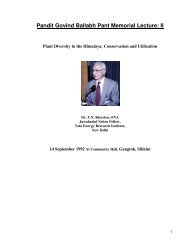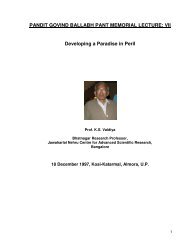Pt. Govind Ballabh Pant Memorial Lecture : XI
Pt. Govind Ballabh Pant Memorial Lecture : XI
Pt. Govind Ballabh Pant Memorial Lecture : XI
- No tags were found...
You also want an ePaper? Increase the reach of your titles
YUMPU automatically turns print PDFs into web optimized ePapers that Google loves.
Apart from prescribing the number of culms to be extracted fromclumps of different sizes, the sylvicultural practices followed at the WestCoast Paper Mills involved the operation of cleaning of the thornycovering that develops naturally at the base of a bamboo clump,especially in the case of Bambusa arundinacea. This “clump cleaning”operation was meant to decongest the clump and promote better growthof the new shoots. Our studies showed this practice to be actuallycounter-productive, for the removal of the thorny covering renderedthe young shoots readily accessible to grazing by a whole range ofanimals, including porcupines, wild pigs, and monkeys as well asdomestic livestock.This brings me back to the theme of people’s knowledge. Ourstudies were triggered by the claims of basket weavers that it was thepractices and pressures of the paper industry that was the cause of thedecline of Karnataka’s bamboo resources. On the contrary, the industryas well as Forest Department claimed that over-harvests by villagersand excessive grazing by their livestock caused the decline. Right fromthe beginning therefore we tried to understand the practices followedby, and investigate the relative impacts of the rural as well as theindustrial sector. We discovered that the villagers never cut the bambooculms right at the base. Rather, they left the thorny covering of the clumpintact and cut the bamboos at a height of about a meter and a half. Infact, our conversations revealed that the villagers were fully aware ofthe problems caused by clump cleaning and made sure that their ownpractices did not expose the new shoots to grazing.Science as an inclusive enterpriseClearly then the so-called scientific management of bambooresources was riddled with problems. This is not an isolated example;in fact, the entire management of forest, wildlife and biodiversityresources of the country is grounded in a faulty paradigm. It is truethat this management follows certain systematic procedures; but scienceis not a matter just of systematic procedures. Rather it is a system ofcontinual open scrutiny of the procedures being employed towards anygiven set of objectives, such as estimation of bamboo stocks and yieldsthat can be sustained, or an assessment of tiger numbers, and of thelevel of reliability of the results these procedures produce. As a matterof fact, skepticism is at the very heart of scientific inquiry. Therefore,the main ingredients of the scientific enterprise are:15











